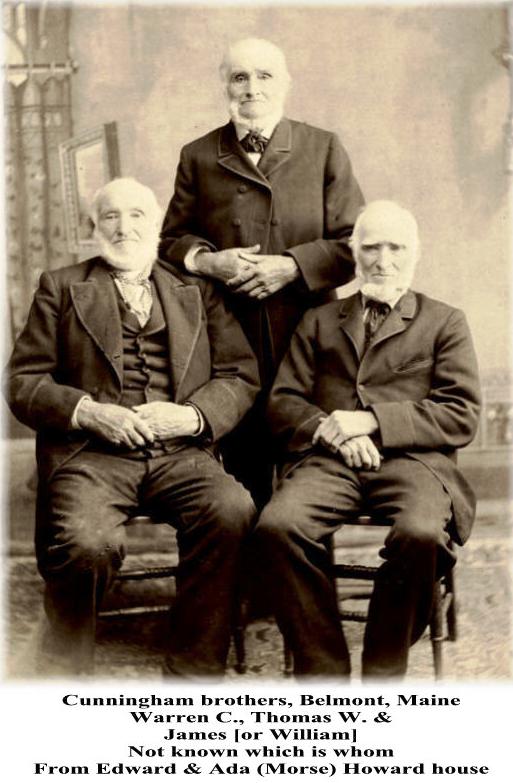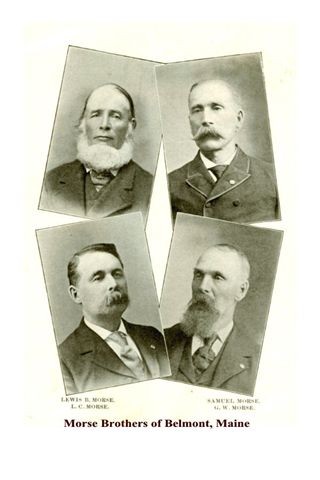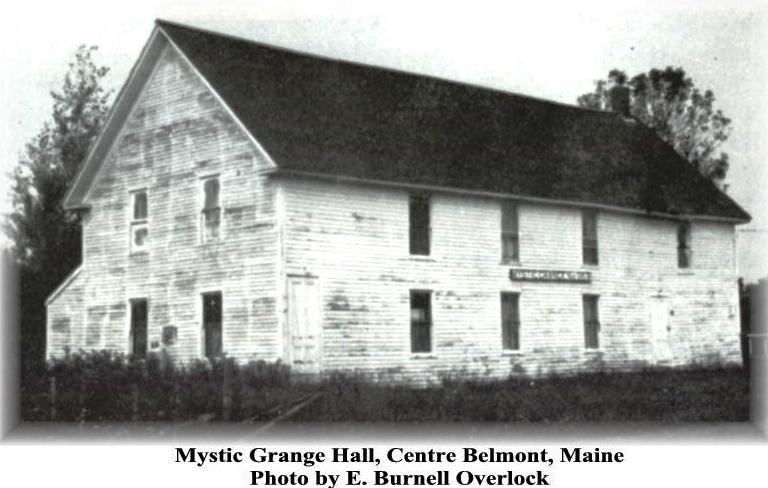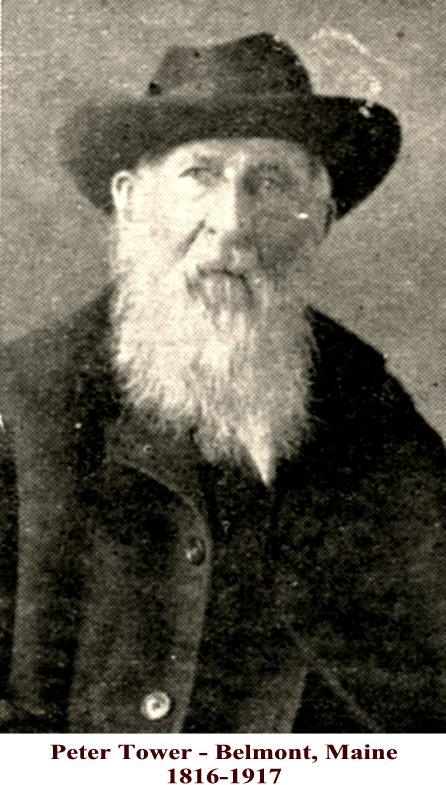
Waldo County, Maine Gen Web Site
Belmont, Me. Part of Greene Plantation
By Isabel Morse Maresh - 6 April 2010
The territory which covers the Tri-Town area of Belmont, Searsmont and Morrill was once Greene Plantation. Belmont and Searsmont were set off as separate towns February 5, 1814. At that time Belmont included what is now Belmont and Morrill.
The Plantation of Greene, which was owned by David Sears, Israel Thorndike and William Prescott, was six or more miles inland from the Coast, according to where you were. Native Americans were living on the land before the settlers came.
At the time of the enumeration of the Census of 1800, which had been taken every ten years since 1790, the area was called the Plantation of Quantabacook, west of Belfast. There were twenty families in the Plantation, with one hundred and eighteen souls. At that time it was in the County of Hancock, in the Commonwealth of Massachusetts. The settlers had come from Ireland, New Hampshire, Kennebec, Damariscotta, and other places.
The 1907 Town Register recorded that Nathaniel Tilden, who was a soldier of the Revolutionary War, came about 1797 with his wife and family and settled near the pond which bears his name. It was told that he and his family were beyond civilization, when one morning he heard a rooster crowing. He took his family and an axe, spotting the trees as they followed the sound of the rooster, when he came upon a new clearing in the wilderness. There they met a woman who was glad to see another family. She gave his children some bread and butter, and excused herself because it was the Sabbath and she could not entertain them on that day.
The first white child born in the settlement was James, the son of Daniel Dolloff, who had come from New Hampshire. Other settlers came to the new settlement, including Nathaniel Cross and his sons, David and Joseph, from Exeter, New Hampshire, settling in what is now Morrill, Me. John Gray arrived later, bringing apple scions to graft trees on his land in Belmont.
William Cunningham and his wife, Susanna Carter, came from New Hampshire, and settled on Lot. No. 21, where they cleared the land, built the farm buildings, and raised their family on what became the Howard farm. William and Susanna had three sons, William, Jr., Thomas W., and Warren C., born after 1800, in the new settlement. The Cunninghams were prominent farmers and coopers in Belmont. Thomas served as a Selectman, Town Clerk, and as a Justice of the Peace. Warren C. served as a Selectman and Town Treasurer. William died in 1881, Thomas and Warren died a month apart in Dec. 1898, and Jan. 1899.
|
|
 |
Due to dissention between North and South Belmont, and the distance that residents of the town had to travel to attend Town meetings at Belmont Corner, one hundred and three residents of the northern part of town petitioned Governor Anson P. Morrill of the State of Maine to make them a separate town. The petition was approved on March 3, 1855, with the town being named Morrill, after the Governor.
The store of John Crawford at Belmont Corner burned on the night of May 23, 1855, nearly three weeks after Morrill became a town. John Crawford’s store was probably not very large according to today’s standards. Crawford rebuilt his store, but at the time he was Belmont Town Clerk, and all of the Town records burned in his store fire. The records would have been of the Town of Belmont, the part that became Morrill, and possibly some records of Greene Plantation.
John Crawford suffered from the disease of consumption, commonly called tuberculosis. In the fall of 1855, he went by ship to Cuba, thinking that the milder air would be beneficial for his disease. When no relief was obtained, he died on his passage home, just one year after his store fire in 1855.
When the Civil War broke out, Belmont sent forty-two men to fight for the Union. Of these, eleven men lost their lives. Perhaps the family who sent the most to fight in the Civil War, was Barnard Morse and his wife, Mary Ann. Their youngest son, Lucius, had been on a coastal ship in Cuba in 1862 when he had seen the defiance of the Rebels in flying the Confederate flag. He told his brothers about what he had seen when he arrived home.
| Lucius had
enlisted in the Union Army at age sixteen, but his parents would not
allow him to go to War. In Sept. 1863, at a special Town Meeting in
Belmont, a call came to raise a quota of men for enlistment. At that
time, his older brothers, Lewis B., Samuel, and George W., and also
Lucius’s friend, David Ordway enlisted in the Army.
Lucius was still imploring his parents to let him go. Seeing that his brothers were leaving, Lucius’s mother finally relented and allowed him to go with them. They became well-known in the Army as being four brothers from the small Town of Belmont, Maine, all serving in Company B. of the Twenty-Sixth Regiment of Maine Volunteers. In the South Lucius came down with malarial fever, and was unconscious for some days. At the same hospital were Samuel, who had the fever, and Lewis who had been wounded. They kept the promise to their mother, and would not leave the Hospital until Lucius was able to leave with them. At times they doubted that their brother would live, and he might not have, without their care. The brothers all returned to Maine where they were farmers, mill workers, and prosperous family men. Samuel and Lewis B. resided in Belmont. George W. was a Justice of the Peace, marrying many couples in his home town of Belmont, Me. Lucius lived in Liberty, where he had mills on the river, had a casket factory, as well as being a Justice of the Peace, and a legal worker to obtain pensions for fellow soldiers.
|
 |
|
|
| In 1875, a
group of Belmont residents met at Belmont Corner and formed the Grange
society, called the “Patrons of Husbandry”. They built a Hall at Centre
Belmont, which was dedicated on July Fourth, 1876. The Grange was the
hub of the community for over one hundred years.
|
 |
|
Sometime after this, Horace Chenery came to Centre Belmont, buying up local farms and buildings to build a rural empire of acreage, called “The Pastures”. His Model farm at one time employed over sixty persons. |
 |
Harold Marriner, son of Fred Marriner, owned much of what had been “The Pastures”. He was a livestock dealer, operating a slaughter shop, where he sold meat, quality hotdogs and other meat products. He employed several men, including Keith Tower, who was a butcher. Many years later, in the 1960’s, a man by the name of Mr. Flowers owned part of the property where he raised Hereford cattle.
|
| An article in the Republican Journal in 1914 was titled, “Belmont’s Centenary”, which was written about Peter Tower, who had been born April 24, 1816, about two years after Belmont was incorporated. He came with his parents to Belmont when he was eleven years old from Plympton, Massachusetts. Peter Tower had grown with the town. He was a farmer and cooper in Centre Belmont, where he raised his family. |
 |
At the time the article
was written, Peter Tower was ninety-eight years of age. He had six
children, four grandchildren, thirteen great-grandchildren, and thirteen
great-great-grandchildren. Peter Tower died Feb. 24, 1917, almost one
hundred and one years of age. He is buried in Pease Cemetery with his
wife, Hulda (Frohock) Tower, who died many years before him.
|
Belmont was always known as a farming community until the last few years. The last dairy farm, that of Rick Morse, ceased to produce milk about two years ago.
There are many tales yet to be told of the descendants of the early settlers of the Town, which, if written, would fill many books.
Wonderfully written by
Isabel Morse Maresh
Comments are welcome and relatives expected. 14 June 2010

©
2006-2012 All
rights reserved
Isabel Morse Maresh
This page last updated
on December 31, 2011